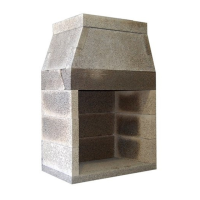58
Specialty Applications - Two Story Stacked Installations
General Information:
To install one MAGNUM replace and DM 54
chimney system above another, as in a two story stacked
installation, both the upper and lower replace installations
require a concrete slab that is supported down to footings via
concrete or steel support structure.
Frequently in two story stacked installations the lower
unit is supported by a slab-on-grade (as in a basement), whereas
the upper unit is a typical off-grade support slab.
The off-grade slab for the upper unit must be built with sufcient
width in order to accommodate the width of the upper replace
plus the width of the by-passing chimney system rising from the
lower unit. (Figure 121)
The slab for the lower unit will need to be built with
enough width to provide support for the lower replace unit
plus the bearing surface for the support columns needed to carry
the offset chimney sequence of the lower system. (Figure 121)
Floor-to-Floor Height Considerations:
In order for the lower replace installation to have
enough overhead height clearance for its chimney to rise at a
thirty degree (30°) angle of offset (maximum angle of offset as
allowed by code) and bypass to one side of the rebox in the
upper location there are minimum required oor-to-oor height
dimensions. (See chart, page 54, Dimension “F”)
The minimum oor-to-oor height required for an
installation is determined by calculating the total horizontal
distance the lower ue must travel to the left or right for it to
bypass to one side of the upper replace
(see calculating offsets on page 41).
The total amount of horizontal chimney offset travel
distance will be determined by two factors:
1. The width dimension of the upper unit; and
2.The horizontal distance between centerlines of the
proposedupper and lower units.
Example:
If the upper replace and the lower replace sit on the
same centerline then the required oor-to-oor dimension is
at a maximum (See Figure 122 and chart, page 50 dimension,
column “F”.)
For every 3” of horizontal distance separating the
centerlines of the upper and lower units the overall height of the
offset sequence is reduced by one offset block or by 6”.
Notes:
A raised hearth at the lower replace will increase
the minimum oor-to-oor height requirement by the height
dimension of the raised hearth.
In the interest of clarity the drawing on pages 58 & 59
(Figure 121 & 122) of the offset chimney sequence does not
show the offset block support columns as required for offset
sequences and as described on page 47 of this manual.
FIGURE 121

